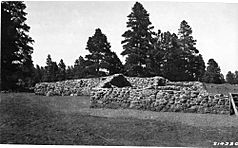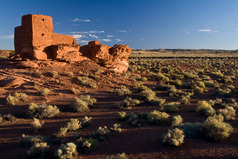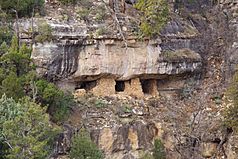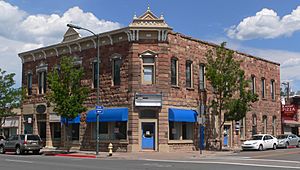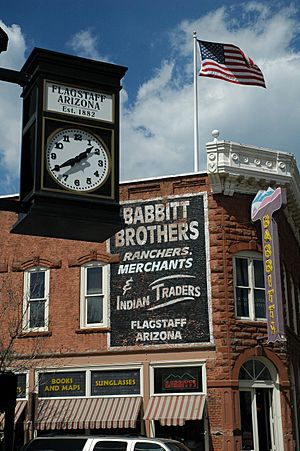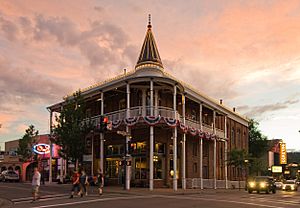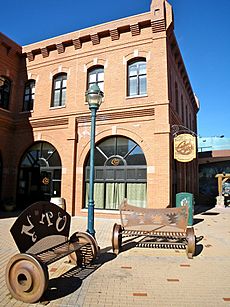History of Flagstaff, Arizona facts for kids
Flagstaff is a city in northern Arizona, USA. It is the main city of Coconino County. People have lived here for a very long time. Native American groups like the Sinagua lived on this land first.
Later, in the mid-1800s, explorers like Antoine Leroux and Edward Fitzgerald Beale traveled through the area. They helped create a wagon trail. A small town grew near a spring along this trail. Important families like the McMillans, Riordans, and Babbitts helped build Flagstaff. They focused on farming and built many red stone buildings that you can still see today.
Over time, the wagon trail was replaced by railroads and highways, like Route 66. This helped tourism grow. Flagstaff is near amazing natural places, including the Grand Canyon. Even during the Great Depression, tourism helped the city's economy. Later, the city faced challenges, but a special project in the 1990s helped it become lively again. Flagstaff is also famous for astronomy. It's high up (about 7,000 feet (2,100 m)) and has clear, dark skies, making it a great place to study stars.
Contents
Ancient People of Flagstaff
The Sinagua people were an ancient culture in Arizona. They lived in a large area from about 500 CE to 1425 CE. This area included the land where Flagstaff is now. The Northern Sinagua started living in the pine forests around the 5th century. They moved into the Flagstaff area around 700 CE.
The Sinagua were mostly hunter-gatherers. But they also started farming maize (corn) in the 8th century. They learned how to irrigate their crops from their neighbors, the Hohokam. They also grew beans and squash. When Sunset Crater erupted in 1064 and 1066, ash covered the land. This ash made the soil very rich and good for farming.
The Sinagua lived in different places over time. They built homes at Wupatki National Monument and Elden Pueblo. They also farmed and lived around Walnut Canyon National Monument. They farmed on the rim of the canyon. Later, in the 12th century, they moved into cliff dwellings inside the canyon. The Sunset Crater eruption led to more people moving to the area. Ancestral Puebloans and Cohonina people also came to the Wupatki site.
The Sinagua people left the Flagstaff area by the early 1400s. We don't know exactly why they left their homes. Some ideas are that they ran out of resources, there was a long drought, or they had conflicts with new groups like the Yavapai. The Sinagua likely moved north and became the Hopi people. The San Francisco Peaks, which are north of Flagstaff, are a very important sacred place for the Hopi and other Native American groups.
The Yavapai people started to develop their own culture around 1300 CE. Before Western settlers arrived in the 1860s, the Yavapai lived in the land up to the San Francisco Peaks. They sometimes had conflicts with the nearby Havasupai and Hualapai people. Even though these groups spoke similar languages, they had stories about a disagreement that separated them.
The land of the Northern Tonto Apache also overlapped with the Flagstaff area. Two Tonto Apache tribes lived near present-day Flagstaff. These were the Oak Creek band and the Mormon Lake band. They were hunter-gatherers and moved around places like Mount Elden, Lake Mary, and Stoneman Lake.
Spanish explorers did not settle in Flagstaff. But Spanish missionaries were about 65 miles (105 km) away in 1629. Later, in the 17th century, Spanish Franciscans gave the San Francisco Peaks their name.
How Flagstaff Began
In the 1800s, there was a wagon road through the Flagstaff area. It was built by Edward Fitzgerald Beale's men. A spring called Antelope Spring was nearby. There was also a supply station from 1856 to 1876 near Leroux Springs. These springs are named after Antoine Leroux, who guided an expedition there in 1851. Many believe Flagstaff exists because of Leroux and his expedition.
The first non-Native settlement was a saloon opened by Edward Whipple in 1871. The area was then called Antelope Spring. The first permanent home was built in 1876 by Thomas F. McMillan. He built a cabin north of where the main town is now. McMillan was a successful sheep farmer and helped develop northern Arizona.
The city was officially founded on July 4, 1876. A group of scouts from Boston raised a ponderosa pine flagpole. This was to celebrate 100 years of the United States. This flag-raising gave the city its name. Other stories also talk about flagstaffs (tall poles with flags) that might have named the city. One story says a surveyor tied a flag to a tall pine in 1855. Another says Beale's men raised a flag in 1859.
When the Atlantic and Pacific Railroad was built in 1882, the town had different names. It was called Flagstaff Spring, then Old Town Spring, and finally just 'Old Town'. A fire destroyed much of the original settlement. After the fire, a new community was built a few hundred yards away and called 'New Town'. The burnt area became 'Old Town'. Many buildings used local red sandstone, which is fire-resistant. This stone became popular for building. The name Flagstaff was brought back in 1884 when a post office opened.
Flagstaff Grows and Develops
Flagstaff grew a lot in the 1880s. Its main businesses were timber, sheep, and cattle. By 1886, Flagstaff was the biggest city on the railroad line between Albuquerque and the West Coast. It had 600 people and many saloons. In 1888, Thomas McMillan bought a building and turned it into the Bank Hotel. This building is still there today. When Coconino County was created in 1891, Flagstaff became its main city.
In 1892, stagecoach tours to the Grand Canyon started from the Bank Hotel. The hotel also had an opera house for shows. In 1894, astronomer Percival Lowell chose Flagstaff for a new observatory. He was impressed by its high elevation and clear skies. The Lowell Observatory was built on Mars Hill, overlooking the town. Two years later, a special telescope was installed there.
Flagstaff officially became a town in 1894. It grew fast because it was on a busy transcontinental railroad line. About 80 to 100 trains passed through every day. The Arizona Lumber and Timber Company was founded by the Riordan brothers. They brought electricity to the town. The Riordan brothers also helped protect ancient Native American ruins. The Babbitt brothers started the CO Bar Ranch for cattle in 1886.
The Babbitt family became very important in northern Arizona. They opened many different businesses, including stores, theaters, and even a funeral home. They also added sheep to their cattle farm. One of their descendants, Bruce Babbitt, later became the Governor of Arizona. People used to say, "God made northern Arizona, and then he turned it over to the Babbitts to run."
The Northern Arizona Normal School opened in 1899. It later became Northern Arizona University (NAU) in 1966. The Flagstaff Symphony Orchestra gave its first concert in 1899 and still performs today.
On January 1, 1900, John Weatherford opened the Weatherford Hotel. In 1911, Weatherford opened the town's first movie theater. It collapsed in heavy snow, but he soon replaced it with the Orpheum Theater. Both the Weatherford Hotel and Orpheum Theater are still used today.
Arizona became a state in 1912. One of its first senators, Henry F. Ashurst, went to school in Flagstaff. He worked at the county jail and read law books, which made him want to become a lawyer.
Flagstaff became known as the "City of Seven Wonders" in the early 1900s. These "Wonders" included the Grand Canyon, Oak Creek Canyon, and Sunset Crater. This helped bring more tourists to the city.
Route 66 and City Growth
The railroad was very important to Flagstaff for a long time. But in 1926, Route 66 was completed through Flagstaff. Business owners supported Route 66 because they knew it would bring more tourists. The Babbitt family even opened a car dealership. To welcome tourists, the people of Flagstaff helped fund the Hotel Monte Vista, which opened in 1927.
Flagstaff officially became a city in 1928, with over 3,000 people. In 1929, the city's first motel, the Motel Du Beau, was built. It was described as "a hotel with garages for the better class of motorists." Flagstaff became a popular stop on Route 66 because it was close to the Grand Canyon and other natural parks. In 1926, the Santa Fe Railroad opened a new train station in Flagstaff. Front Street was renamed Santa Fe Avenue.
In the 1920s, timber was still Flagstaff's main business. But by the end of the decade, tourism took over. The main street changed to have more diners and motels. In 1928, the Museum of Northern Arizona opened. Its workers even stopped a movie company from destroying Sunset Crater for an explosion scene!
During the Great Depression, many unemployed people traveled Route 66. Some stopped in Flagstaff, which put a strain on the city's resources. But because Route 66 was so important, it received a lot of government funding. This helped Flagstaff's unemployed people find work building highways. By the end of 1934, Flagstaff had recovered financially. In 1936, the city's first hospital opened. During World War II, Route 66 was used to move military supplies. This brought even more growth to Flagstaff, and its population doubled.
People in Flagstaff created the first ski run in the mountains in 1938. In the 1950s, a road was paved north of the city. This made Flagstaff a seasonal ski resort. In 1955, the United States Naval Observatory built a station in Flagstaff. This is where Charon, Pluto's moon, was discovered in 1978. The Naval Observatory also helped Flagstaff become the first city to have light restrictions in 1958. This was to keep the night sky dark for astronomy.
Flagstaff continued to grow in the 1960s. The Lowell Observatory became a National Historic Landmark in 1964. Buffalo Park, a large park with wildlife, opened in 1966. During the Apollo program, the Clark Telescope at Lowell Observatory was used to map the Moon. This helped astronauts choose safe landing spots. Astronauts even trained in the volcanic areas around Flagstaff. Many asteroids and planets have been named after Flagstaff and its astronomy history.
Challenges and Comeback
In the 1970s and 1980s, many families moved to Flagstaff because of its small-town feel. But there weren't enough jobs for everyone. The city's downtown area also started to decline. Many old buildings were torn down. Businesses like Sears and J.C. Penney left downtown for a new mall. To protect historic buildings, the Railroad Addition Historic District was added to the National Register of Historic Places in 1983.
In 1987, the city made a new plan to improve downtown. They wanted it to become a center for finance and government. The city built a new city hall and library. In the 1990s, downtown Flagstaff became more cultural again. Store owners supported programs to restore the area. The city hired a new manager who had experience revitalizing other towns.
As a result, downtown sidewalks were repaved with decorative bricks. New shops and restaurants opened, taking advantage of the area's history. The old sandstone buildings were restored. Heritage Square was built as a central gathering place, showing the history of the area. The local Flagstaff Pulliam Airport added more flights. The school district also grew. Microbreweries and craft restaurants opened downtown. Partnerships were also created to protect the surrounding forests.
On October 24, 2001, Flagstaff became the world's first "International Dark-Sky City." This means it's recognized for its efforts to keep the night sky dark and free from light pollution. In 2012, it was named "America's First STEM Community." STEM stands for Science, Technology, Engineering, and Math.
New industries have also grown in Flagstaff. Nestlé Purina PetCare has a large factory there. Flagstaff has also become a popular place for altitude training for elite athletes. Athletes train here because of the high elevation. Between 2012 and 2019, a center in Flagstaff trained over 85 Olympic medalists from many different countries.



